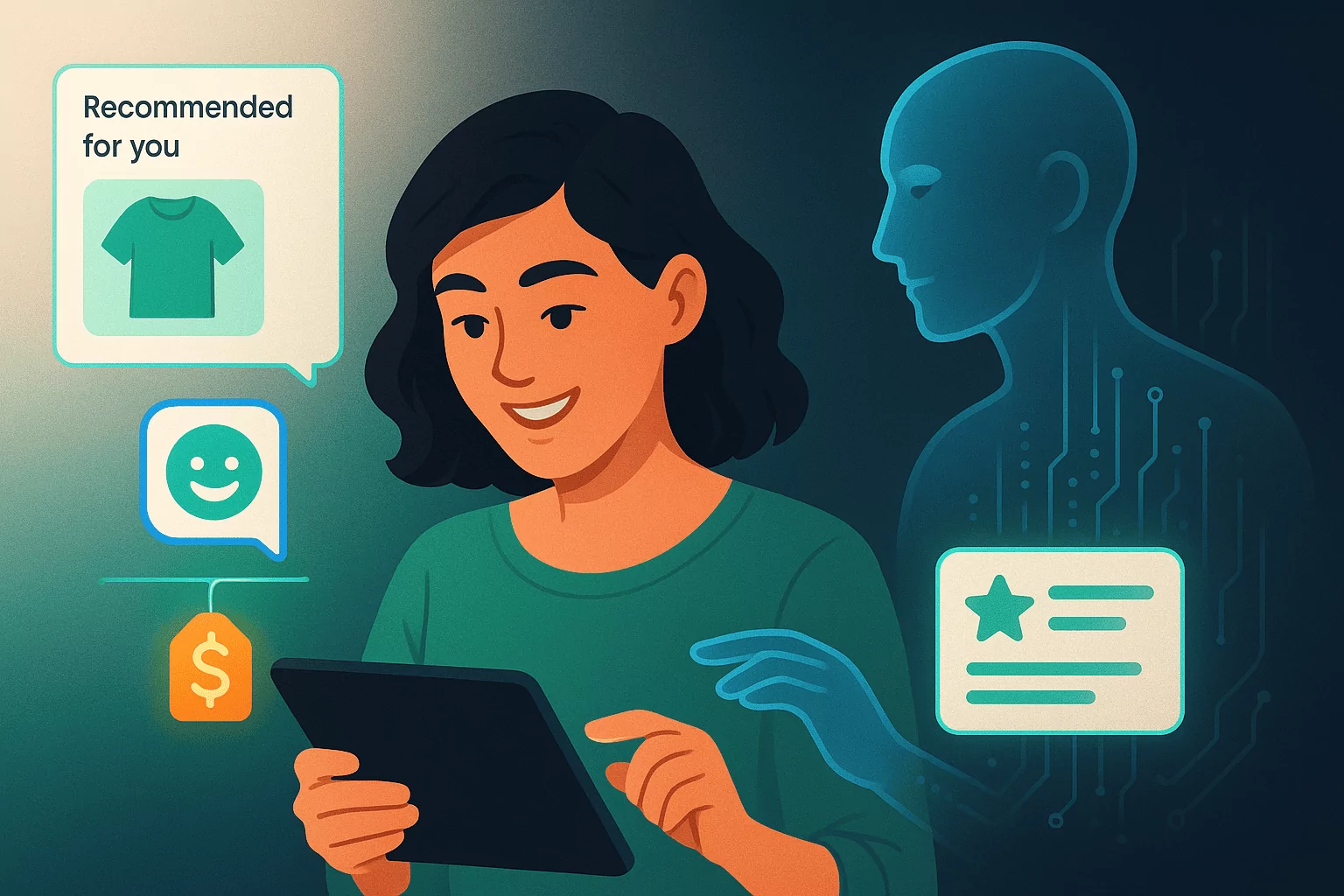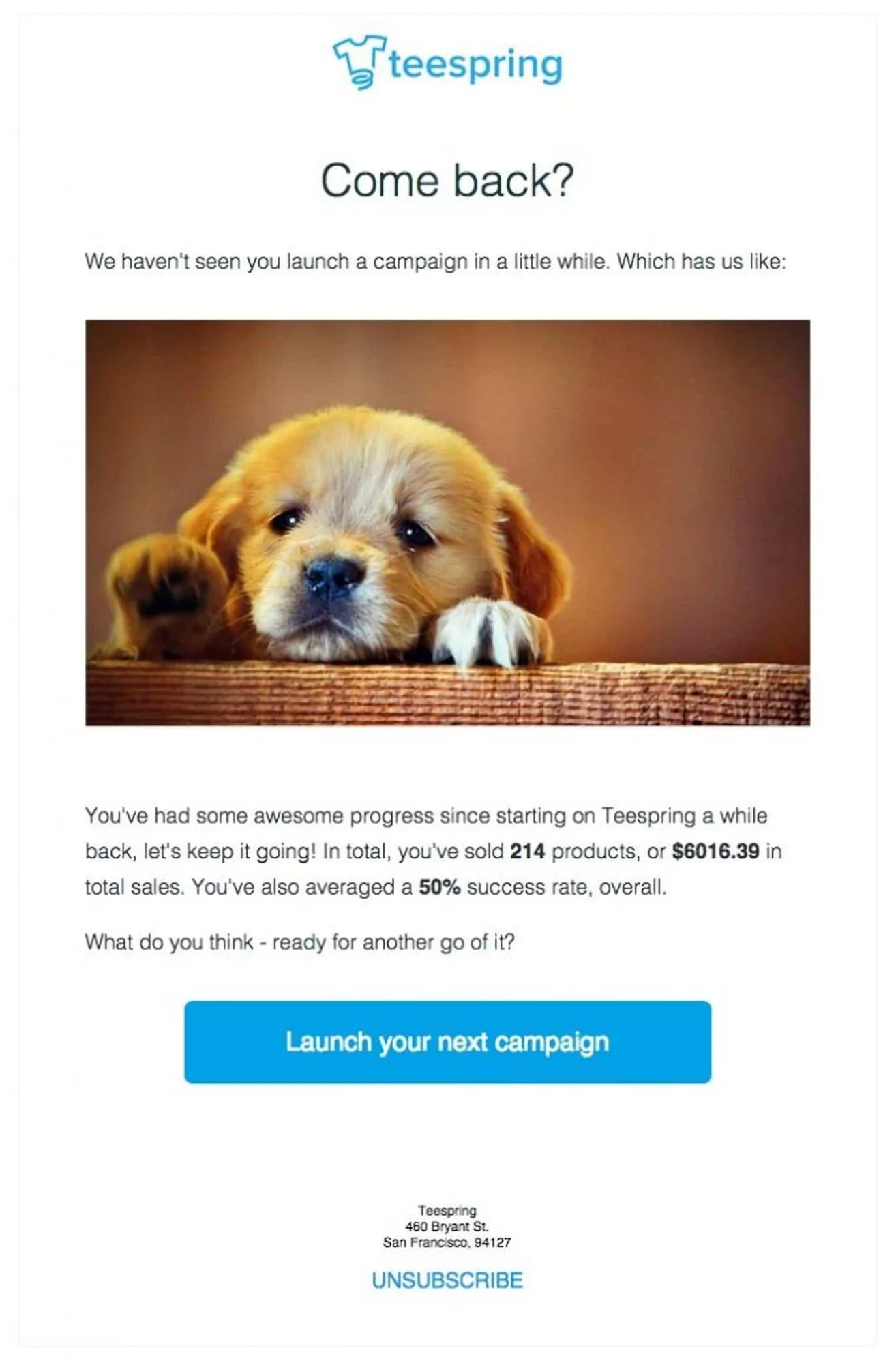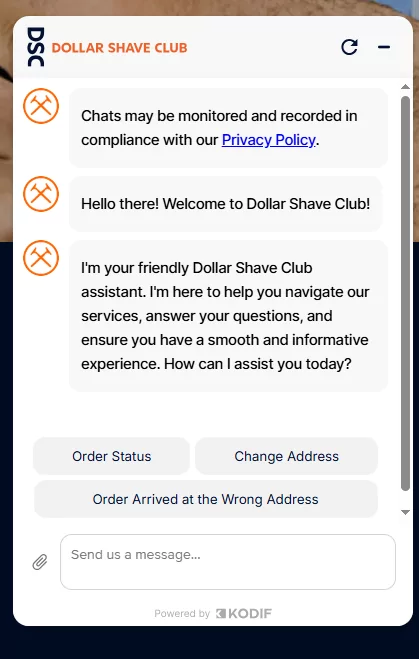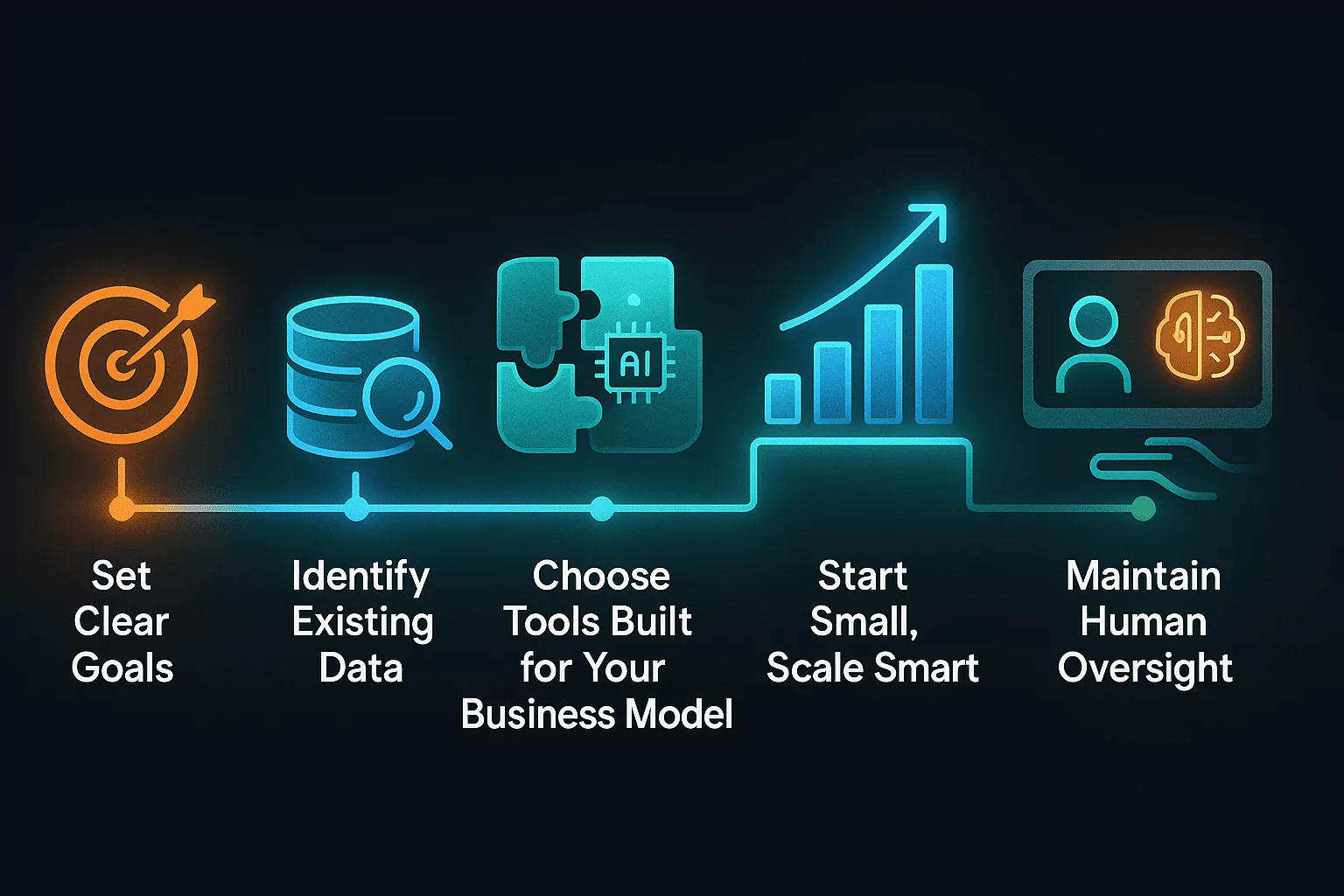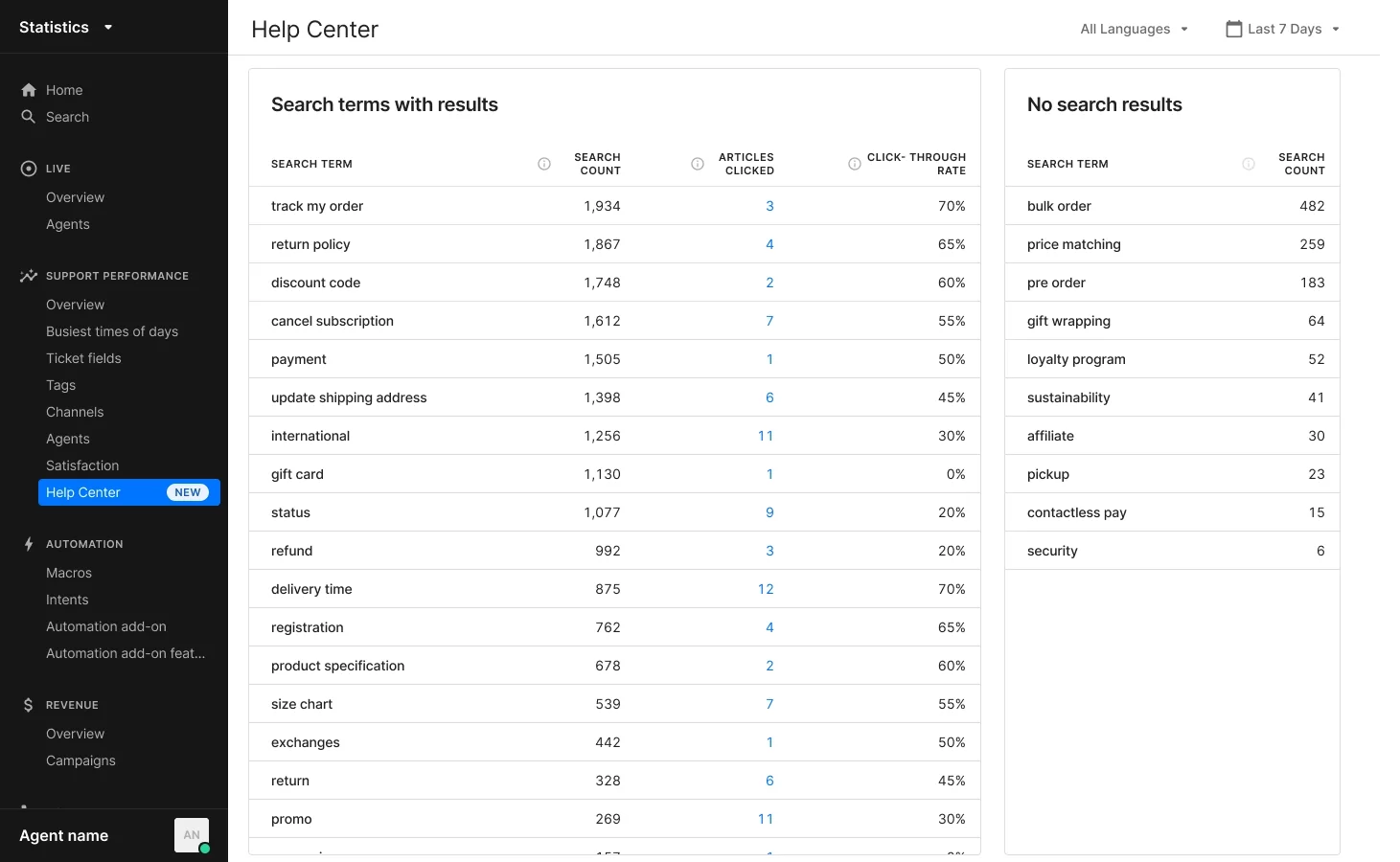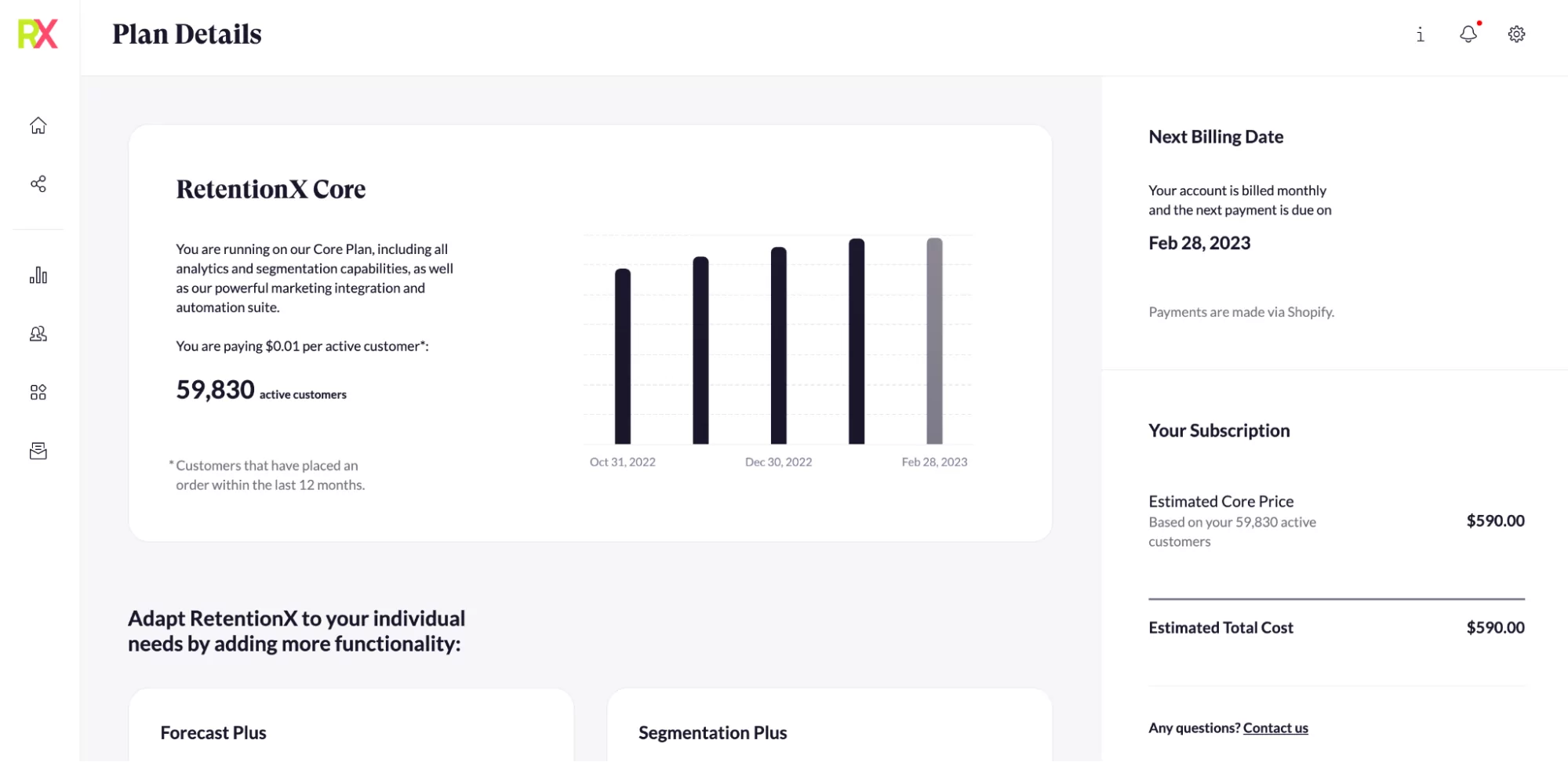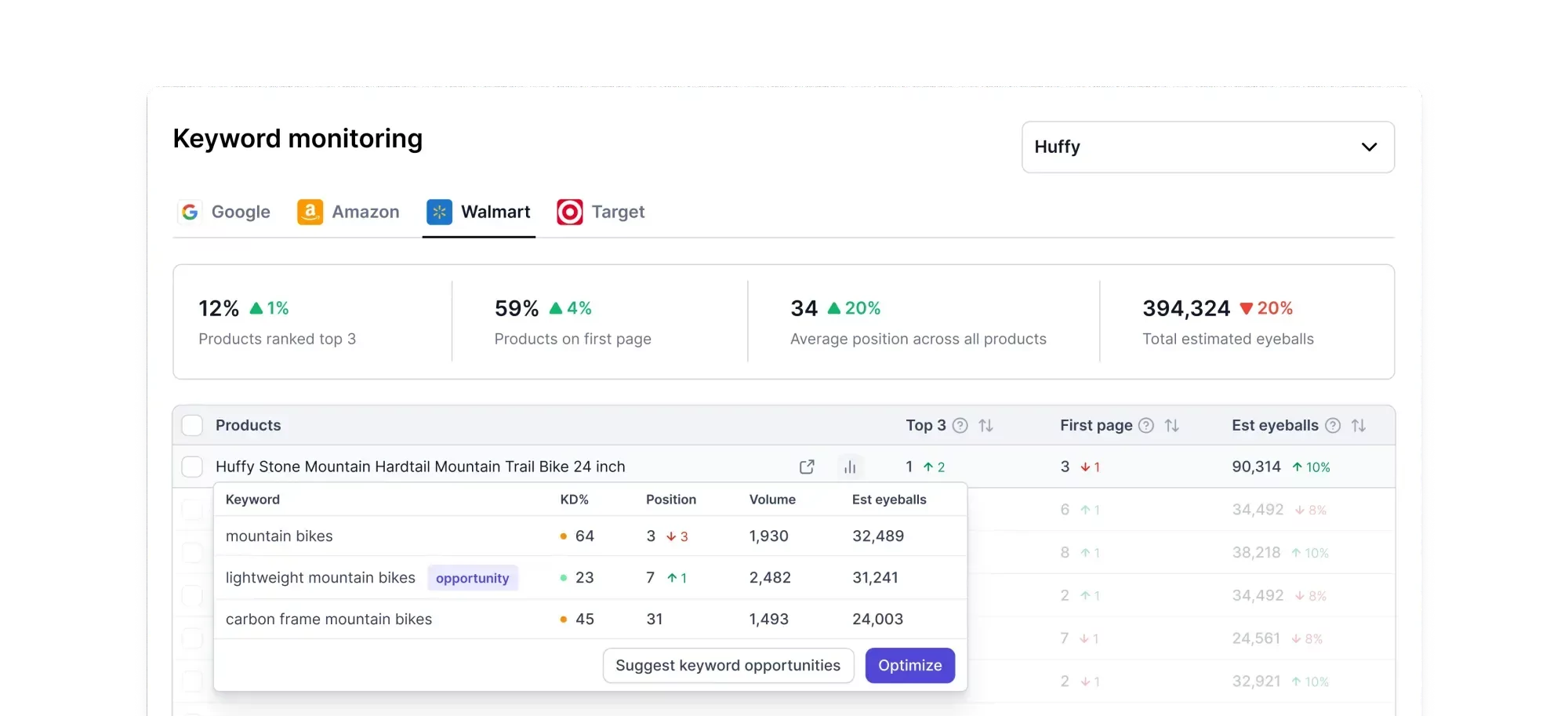What AI Looks like in ecommerce today
AI refers to a set of technologies that help business owners apply data, automation, and personalization to improve the customer experience in subtle but powerful ways.
Many e-commerce businesses already use AI to enhance how customers discover products, receive support, and interact with their brand, as well as how they manage inventory, forecast revenue, and reduce churn.
AI isn’t just one thing; it’s a whole range of different technologies. Here’s a summary of the main types of AI most relevant to e-commerce and what they do.
Machine learning (ML)
Machine learning algorithms learn from patterns in data and make predictions or decisions based on that learning. In e-commerce, that could mean identifying which products a shopper is most likely to buy, or flagging when someone is at risk of churning.
Read our report to find out what average churn levels look like for your industry, country, business model and more.
Natural language processing (NLP)
NLP is what helps computers understand and respond to human language. It’s the technology behind well-known assistants like ChatGPT and Google Gemini.
It powers AI chatbots, enhances search bars to understand vague or conversational queries and enables voice-based online shopping.
Generative AI
Generative tools like ChatGPT or Midjourney create new content based on prompts.
In e-commerce, this can be used to generate product descriptions, social media captions, ad copy, or even product imagery. It saves time and helps teams produce more without hiring extra writers or designers.
Predictive Analytics
Predictive models use historical data to forecast future outcomes. For example, how much stock you’ll need next month, or how likely a customer is to renew their subscription.
It’s especially useful for subscription businesses with recurring revenue and order patterns.
For example, Netflix uses predictive analytics to anticipate when a subscriber is likely to cancel based on:
- Drop-off in viewing activity
- Customer interactions
- Device usage patterns
- Billing behavior (e.g. failed payments)
Their models assign a churn probability score to each user, allowing the company to take action before cancellation happens.
This might include:
- Proactive retention emails (“We noticed you haven’t watched anything in a while…”)
- Highlighting new content tailored to the subscriber’s preferences
- In some cases, offering discounts or pause options to reduce cancellation
E-commerce AI Use Cases: Optimizing Every Stage of the Customer Experience
Talking about the technologies can make AI seem abstract. However, different tools help at different stages of the buyer journey.
Once you understand where your customer journey has issues, and what tools you can use to overcome them, the benefits of AI and how to implement it become a lot clearer.
This section lists common areas where e-commerce businesses currently use AI.
Personalizing the shopping experience
Personalization is one of the most visible and valuable uses of AI in e-commerce. It turns generic online stores into tailored, relevant experiences that help customers find what they’re looking for faster and with less friction.
Common examples include:
Product recommendations
Machine learning models suggest items based on browsing history, past purchases, cart activity, and what similar users have bought.
Today, smaller e-commerce businesses can use tools like Rebuy or LimeSpot to do something similar.
Amazon’s recommendation engine is the classic example, generating an estimated 35% of its sales.
For instance, the image below shows items that customers who purchased a 6-piece BBQ grill tool set also bought.
This enhances the customer experience by ensuring they can locate everything they need. It also helps improve upselling by making it easy for customers to add more to their cart.
Dynamic category pages and homepages
Instead of showing the same layout to every visitor, AI can reorder product listings and spotlight collections based on what’s most relevant to each shopper.
For example, someone who has previously browsed skincare products might return to a homepage that highlights new arrivals in that category.
Fashion website Zalando uses this. For example, we clicked around a few pairs of sneakers, and when we returned to the homepage, it had completely changed to focus on footwear.
Smart search and filtering
AI-powered search tools (like Klevu or Searchspring) understand vague or conversational queries like “something for dry skin” or “gift for a plant lover,” and return relevant results, even if those exact words aren’t in any product titles.
A good example of this is fashion retailer ASOS. It utilizes large language models (LLMs) to add context to customer queries, thereby returning a broader range of relevant product suggestions.
For instance, type “outfits for a beach wedding” and this pair of linen trousers comes up, even though the terms “wedding” and “beach” aren’t mentioned in the product description at all.
Reverse image discovery
Some fashion and homeware brands let customers upload photos to find similar items. These tools utilize computer vision to match patterns, colors, and shapes, helping turn inspiration into purchases.
2.Smarter marketing and sales funnels
AI tools can help you achieve a more efficient sales process by making your funnels more targeted, efficient, and responsive. Here are some of the ways it can do that:
Predictive targeting
AI can analyse customer data to predict who’s most likely to respond to a particular offer, email, or message.
You can target segments based on things like purchase intent, churn risk, or product interest. Tools like Klaviyo and Mailchimp use this logic to improve open and conversion rates.
Here’s a good example of the kind of automated email that your AI might send to customers at risk of churning. In this example, the Teespring online marketplace is contacting a seller who hasn’t been active recently. The email celebrates their achievements, encouraging them to continue their work.
Send time and frequency optimisation
Rather than guessing when to hit send, AI can analyse each customer’s past behaviour and automatically deliver campaigns at the time they’re most likely to engage. It can also adjust how often they receive emails or texts to reduce unsubscribes.
Dynamic creative
Some platforms use generative AI to automatically generate subject lines, social ad copy, or even entire product descriptions, testing variants to determine which performs best.
Others personalise email content based on browsing or order history, showing different products or offers to different users.
Dynamic pricing
For high-volume ecommerce stores, machine learning can help adjust prices based on stock levels, customer behaviour, or demand trends.
While less common in subscription businesses, some use AI to suggest upsells or flexible tiering options depending on customer usage.
3. AI-enhanced customer service
Customer support can be one of the most significant time and resource drains, especially for small teams or single-person start-ups.
AI helps lighten that load by handling common queries, reducing response times, and improving the overall experience.
The goal isn’t to remove the human element, but to use automation where it adds the most value. Here’s how ecommerce businesses are using AI to improve support:
Chatbots for 24/7 responses
Studies show that AI chatbots can handle up to 70% of basic customer inquiries without needing a human agent.
AI-powered chatbots can answer routine questions instantly and around the clock. These could include “Where’s my order?” or “How do I pause my subscription?”.
These bots use natural language processing (NLP) to interpret queries and provide accurate, helpful replies. Some also escalate to a human agent when needed, keeping the service seamless.
Here’s a good example of one from Dollar Shave Club. As you can see, some of the most common questions are pre-scripted to make the process even quicker and easier for customers.
Predictive FAQs and guided workflows
AI can surface relevant help articles before a customer submits a support ticket, providing a more efficient and personalized support experience.
It does this by looking at the context behind what they are typing and where they have been on your site.
So if the customer had previously visited your payments page and their search says “my payment failed” then the AI knows to offer solutions relating to failed payments.
Voice support and conversational commerce
Larger brands are also experimenting with AI-powered voice assistants. These can handle routine tasks via smart speakers or within apps, making the experience faster and more accessible, especially on mobile devices.
For example, Walmart now connects with Google Assistant. Customers simply activate the voice assistant and instruct it to add an item to their shopping list. Google Assistant then connects to their account on the Walmart website and adds the requested items to their cart.
This can also be applied to support. Customers can ask questions like “Where is my [company name] order?”. The voice assistant would then send this to AI agents at the company and retrieve a response.
Support analytics and prioritization
AI can analyze incoming tickets and detect common patterns. This enables them to flag emerging issues, route queries to the right team, or prioritize urgent requests. This gives support teams better visibility and helps them act faster.
4. Operational optimization behind the scenes
Some of the most powerful ways to use AI occur out of sight from the customer.
Behind the scenes, AI integration helps ecommerce companies improve operational efficiency through enhanced inventory accuracy, streamlined internal workflows, and reduced avoidable costs.
Here’s where it makes the biggest impact:
Inventory forecasting
AI can use data to help predict future demand. This is often based on:
Historical sales data
- Seasonality
- Customer behavior
- External signals (like promotions or weather)
This helps the ecommerce industry avoid two significant risks: overstocking products that won’t sell, or running out of items that are about to become popular.
A good example of an inventory management tool is Inventory Planner by Sage.
It is used by ecommerce businesses to optimize stock levels and reduce overstock or stockouts. It connects with most major platforms and works by analyzing historical sales, seasonal trends, and current stock data.
While it’s not subscription-specific, it’s widely used by stores that need greater control over purchasing and planning, especially during high-volume sales periods.
Product tagging and categorization
AI can automate the process of tagging and categorizing new products, using image recognition and text analysis to assign the right labels. This makes filtering and discovery more accurate on the front end and reduces manual admin for your team.
Fraud detection
Machine learning models can flag suspicious transactions in real time, such as mismatched shipping and billing addresses, unusual purchase patterns, or repeated payment failures.
By learning from past fraud attempts, AI enables faster detection of future threats and reduces the number of false alarms.
Automated content creation
Generative AI tools can write product descriptions, generate meta tags, or even suggest email subject lines.
This reduces repetitive work and helps small teams scale their output without needing to hire additional staff.
A good example of this is the Smart List feature on second-hand fashion marketplace Poshmark.
This is an AI-powered listing tool that automates product uploads by generating titles, descriptions, and key attributes from a single photo.
It uses image recognition and natural language processing to identify details like brand, category, color, and style, helping sellers create listings quickly and consistently.
While designed for peer-to-peer fashion resale, it demonstrates how AI can streamline content creation at scale, reducing manual input and speeding up time to publish.
Why AI Is A Must for Subscription Ecommerce Businesses
AI is especially powerful in subscription ecommerce businesses. That’s because subscriptions generate consistent, long-term customer data.
With every renewal, skipped order, product rating, or churn event, you’re building a clearer picture of what your customers want and how they behave over time.
AI tools can turn that data into smarter decisions, stronger retention, and better long-term planning, all without needing a data science team.
In this section, we’ll look at how AI supports these critical parts of your business.
Retention and lifetime value
In subscription ecommerce, retention is everything. One-time purchases matter less when your business depends on recurring revenue.
AI can help you identify which customers are at risk of churning, why they might be about to leave, and what you can do to keep them.
Here’s how AI helps protect long-term value:
Churn prediction: Machine learning models can flag at-risk subscribers by analyzing behavior, like skipped boxes, reduced customer engagement, or support tickets. This gives you time to act before a cancellation happens.
Subbly users have access to built-in churn prediction and revenue forecasting tools, designed specifically for subscription logic.
Targeted retention campaigns: Once you know who’s at risk, AI can trigger personalized emails or offers, such as a discount, loyalty perk, or quick-pause option, based on what’s most likely to work for that individual.
For example, a subscriber who has skipped two boxes in a row might be flagged as high-risk. AI can automatically trigger an email offering a temporary plan pause, a bonus item in their next box, or a tailored discount. This keeps the interaction timely and relevant, without requiring manual intervention from your team.
Customer lifetime value (CLTV) forecasting: AI can estimate how much each customer is likely to spend over time, helping you prioritize high-value subscribers for tailored retention strategies or premium offers.
Win-back flows: If a customer does cancel, AI can help trigger timely re-engagement campaigns, recommending a relevant product or offer based on their history.
Let’s say a customer who subscribed for 10 months, never skipped a box, rated their last product 5 stars, and cancelled, saying they were “cutting back”.
Your AI platform would likely identify this customer as having a high CLVT and being more likely to return than someone who churned after one order with a 2-star review.
In this case, AI might trigger a personalised email offering a one-month “pause” plan, or a returning subscriber discount; e.g. “Come back for just £10 this month, no long-term commitment.” This lowers the barrier to re-entry while reinforcing the value they already enjoyed.
Optimizing operations across subscription cycles
Subscription businesses deliver on a recurring schedule. This means that consistency and predictability are critical.
Stock planning needs to be proactive, not reactive. Failed payments can increase churn and put a dent in your revenue forecasts.
AI helps by adding foresight, automation, and responsiveness to your subscription cycles. Here’s how:
Smarter inventory planning for recurring shipments
AI can analyse order patterns, seasonality, and customer churn trends to help predict how much stock you’ll need for upcoming cycles. This reduces overstocking and ensures you’re not caught short before a major renewal date.
Dunning and payment recovery automation
Failed payments are one of the most common causes of involuntary churn.
AI helps reduce revenue loss by triggering smart dunning flows. These are automated reminders, retry sequences, and alternative payment prompts tailored to what’s most likely to succeed based on past outcomes.
Revenue and demand forecasting
AI can project upcoming monthly recurring revenue (MRR), accounting for renewals, churn risk, and customer upgrades or downgrades.
This gives operators better visibility into cash flow and helps guide:
- Marketing
- Inventory
- Customer support planning
Deepening personalization over time
One of the biggest advantages of the subscription model is the amount of customer data you generate.
Each renewal, delivery, or interaction adds another layer to what you know about your customers.
AI automatically logs, analyzes and acts upon that data. This enables you to create smarter, more personalized shopping experiences that strengthen loyalty and reduce churn.
Personalizing box contents or product selections
AI can analyse a subscriber’s order history, feedback, and even how often they skip or swap items to recommend better-fit products over time.
Example: Birchbox
Birchbox uses AI to tailor each customer’s monthly box based on both stated preferences and ongoing behaviour.
When a customer signs up, they fill out a profile indicating their skin type, hair type, beauty goals, and product preferences.
AI models then use this input, along with data from similar users and customer feedback, to select the most relevant sample products.
Over time, the system adapts based on how the customer interacts with previous boxes. If someone consistently rates skincare products highly but shows less interest in makeup, the AI adjusts future boxes to reflect that preference.
This approach helps Birchbox deliver a more personalized experience at scale, increasing customer satisfaction and reducing churn across its subscriber base.
Recommending plan changes or add-ons
Machine learning models can detect when a customer may benefit from upgrading, downgrading, or switching to a different plan, based on usage trends, engagement, or historical churn data.
For example, a customer who consistently uses up their monthly supply early might be offered a higher-tier plan with better value per item.
Timing loyalty offers or engagement nudges
AI can also improve the timing and relevance of loyalty rewards. For instance, it might identify when a customer is close to a churn-risk threshold and trigger a retention perk, like a free item, early access, or an extra loyalty point incentive
How to Start Using AI in Your Ecommerce Business
AI may sound complex, but you don’t need a data scientist or a massive budget to get started.
Most ecommerce and subscription businesses already have the key ingredients: customer data, repeatable workflows, and a few pain points worth solving.
Here’s how subscription ecommerce businesses can approach AI adoption.
1. Set clear goals
Before choosing any tools, identify problems that AI can help with. Some starting points might be:
- “We want to reduce churn.”
- “We’re spending too much time answering the same support questions.”
- “We’re not sure how much stock we’ll need next month.”
Once you’ve defined the problem, it’s easier to pick the right solution.
2. Identify existing data
AI works best when it has patterns to learn from, and most ecommerce businesses already generate plenty of usable data.
That includes:
- Purchase history
- Product reviews or ratings
- Email engagement (opens or clicks)
- Subscription behavior (skips, pauses or cancellations)
This data can be fed into AI tools to help them generate insights and automate processes. Without it, it’s unlikely that AI will be as effective
3. Choose tools built for your business model
Not all AI solutions are built with subscriptions in mind. Some are designed for one-off purchases and don’t understand things like churn risk, renewal cycles, or tiered plans.
Subscription ecommerce platforms like Subbly include AI features purpose-built for recurring revenue businesses, such as churn prediction and revenue forecasting, so you can act on insights without needing extra integrations or custom setups.
If you’re not using a platform with built-in AI, look for tools that connect easily to your stack and offer transparency about how they use your data.
Some examples include:
For product recommendations and upselling
Tools like Algolia Recommend use AI to power personalized product suggestions based on browsing and purchase behavior. These are ideal for stores with large catalogs where customer journeys vary widely.
For email and SMS marketing
Klaviyo is a CRM that can use AI to predict customer lifetime value, automate segmentation, and optimize send times. It’s a strong fit for both standard ecommerce and subscriptions when paired with the right data inputs.
For customer service
AI support agent Gorgias uses ecommerce natural language processing to categorize tickets, surface relevant help docs, and even suggest responses.
Tools like this work well in high-volume environments where speed and consistency matter.
For retention analysis and forecasting
RetentionX is an AI analytics tool focused on churn, cohort behaviour, and profitability. It’s particularly useful for DTC brands with repeat-purchase patterns, even if they don’t run subscriptions.
For product content automation
Tools like Hypotenuse AI use machine learning to auto-generate product descriptions, often syncing directly with your catalog. These are great for merchants launching large numbers of SKUs regularly.
4. Start small, scale smart
AI doesn’t need to be a big project. Start with one workflow, like sending re-engagement emails to high-risk customers or automating basic support replies.
Once you see results, you can expand into more advanced uses like dynamic product recommendations or predictive inventory planning.
Some good starting points include:
Use an AI copywriting tool to speed up product descriptions
Add a chatbot that handles FAQs
Analyzing customer data to spot potential churn
5. Maintain human oversight
AI should enhance your judgment, not replace it. Use AI to surface patterns, suggest next steps, or automate the repetitive parts of your business, but always review and refine as you go.
Keep an eye on how your automations are performing, and make sure your brand voice and customer experience remain consistent.
From product recommendations and customer service to smarter forecasting and retention, AI ecommerce tools are already helping thousands of businesses run more efficiently and profitably.
But for subscription businesses, the impact is even greater. The recurring nature of your model means you have access to richer customer data and AI can help you act on it without extra headcount or complexity.
The biggest challenge is identifying where in the customer journey AI will provide benefits and which tool will help you achieve that.
If you’re already using Subbly, many of the capabilities covered here, like churn prediction, revenue forecasting, and automated dunning flows, are available out of the box. No separate tools or data wrangling required.
And if you’re not using Subbly yet, now’s the time to try it.
Subbly is the subscription-first platform built to support smarter growth. We’re constantly seeking new ways to use AI and make ecommerce more efficient for our customers.
For example, we recently announced a new AI website builder. It enables you to build an entire website from scratch in just 10 minutes using a handful of prompts!
Check out our demo video to learn more or start your free trial now and see what’s possible.

